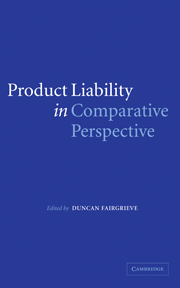Book contents
- Frontmatter
- Contents
- List of figures
- Foreword by Sir Michael Burton
- List of contributors
- Preface
- 1 Introduction
- PART I Country reports
- PART II European influences
- 9 Product liability: basic problems in a comparative law perspective
- 10 The development risks defence
- 11 Approaches to product liability in the EU and Member States
- 12 Product liability – a history of harmonisation
- PART III Comparing systems
- Appendix
- Index
10 - The development risks defence
from PART II - European influences
Published online by Cambridge University Press: 28 July 2009
- Frontmatter
- Contents
- List of figures
- Foreword by Sir Michael Burton
- List of contributors
- Preface
- 1 Introduction
- PART I Country reports
- PART II European influences
- 9 Product liability: basic problems in a comparative law perspective
- 10 The development risks defence
- 11 Approaches to product liability in the EU and Member States
- 12 Product liability – a history of harmonisation
- PART III Comparing systems
- Appendix
- Index
Summary
Introduction
The question how the regime of liability without fault which the Product Liability Directive 85/374/EEC (‘the Directive’) sought to deal with unforeseeable defects has evoked considerable political debate amongst Member States and controversy among commentators. This chapter seeks to describe the issues arising in determining the meaning and scope of the defence, the light shone upon them by reported decisions and the questions which are yet to be resolved whether by the jurisprudence of Community courts or by legislative reform.
History
The protracted and inadequately transparent negotiations over the terms of the Directive have been covered before. It is, however, of relevance to recall the fact that the presence of the development risks defence inspired such disagreement among Member States as to result in the derogation permitting them to omit it from their implementing legislation.
After the publication of the first draft of the Directive in 1976 the Council of Europe produced the Strasbourg Convention on Product Liability in 1977. In the same year the English and Scottish Law Commissions produced Reports on Product Liability. All four recommended the omission of the defence. The first two were eclipsed by publication in 1979 of the second draft, leading to the final form of the Directive and the latter two by the Pearson Royal Commission on Civil Liability and Compensation for Personal Injury which rejected comprehensive reform in favour of sectoral change limited to personal injury cases and excluding damage to property.
- Type
- Chapter
- Information
- Product Liability in Comparative Perspective , pp. 167 - 191Publisher: Cambridge University PressPrint publication year: 2005
- 4
- Cited by

